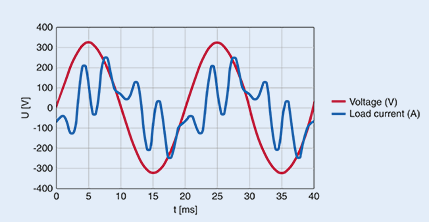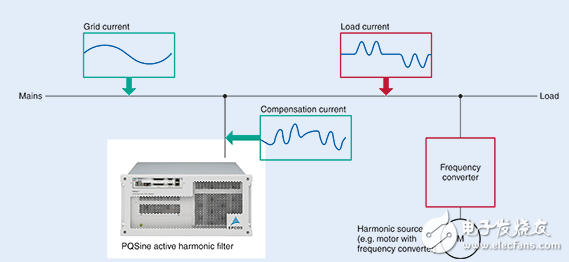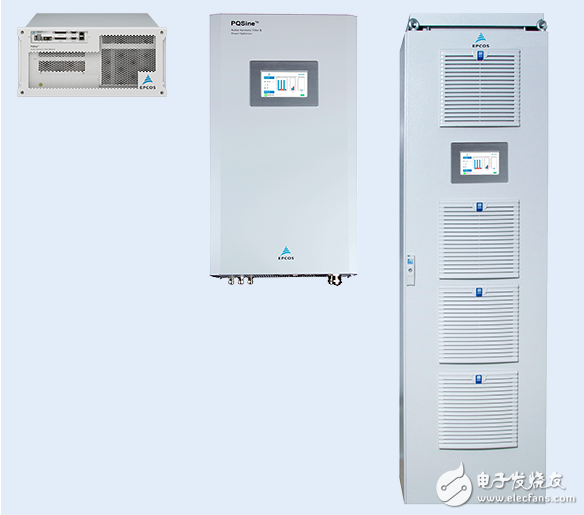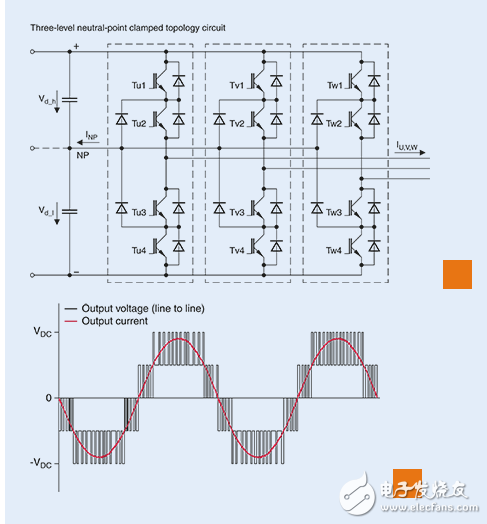As the number of non-linear loads incorporated into the grid is increasing, the harmonic content in the grid is also greatly enhanced, thereby significantly impairing the quality of the power. In view of this, EPCOS has launched (EPCOS) PQSineTM active harmonic filters, which can effectively reduce unnecessary harmonics in the power grid. Linear loads have rarely been used in industrial plants, office buildings, data centers, and even private homes. In contrast, non-linear loads are increasing, such as drives for drive systems, a large number of switching power supplies for IT and communications equipment, and more and more home appliances. Even lighting technology mainly uses nonlinear power supplies (Figure 1). Figure 1: Current supply voltage and non-linear load current

The use of a non-linear load generates unwanted harmonics so that the current no longer strictly follows the sinusoidal voltage change.
Non-linear currents can generate harmonics that can cause sinusoidal voltage distortions that in turn can interfere with other loads. The frequency of harmonics is an integral multiple of the fundamental frequency (a linear frequency of 50 Hz or 60 Hz), its amplitude is variable, and it can be extended to the upper limit of kHz. Harmonic pollution will produce a series of negative effects on power quality, including: due to poor power quality of the power grid, causing other load problems;
The extra current load generated on the zero line, and harmonic currents will gradually accumulate with 3rd, 9th, 15th, and 21st harmonics, causing dangerously high currents;
Inducing phase asymmetry (especially when using a single-phase switching power supply) further enhances harmonic generation.
In addition, harmonics transmitted through data or power lines can severely damage the function of sensitive devices and even destroy them. Typical examples include the plant's process controllers and data center servers, once the data in these locations is damaged by harmonics can cause huge indirect losses. Attempts to eliminate harmonics directly on the load side using passive components, but this requires the provision of a tuned resonant circuit including capacitors and inductors for each harmonic frequency. Moreover, this solution is only applicable to the limited harmonic spectrum. Active harmonic filters compensate for harmonics With the EPCOS PQSine series of active filters, the TDK Group offers a fully-designed, fully-automated solution to many problems due to harmonics and phase shifts. This series of filters is connected in parallel with the harmonic-inducing load to the grid. The core of the filter is a 32-bit digital signal processor (DSP) sampling controller with a sampling frequency of 48 kHz. This series of filters offers industry-leading performance with a response time of only 21 μs. Its new Selective Drive Control (SDC) algorithm is faster than traditional algorithms based on Fast Fourier Transform (FFT) analysis. Based on real-time test data, the PQSine series feeds compensating currents into the grid to counteract non-linear load currents (Figure 2). Figure 2: Functional schematic of EPCOS PQSine

PQSine ensures sinusoidal current waveforms and effectively reduces harmonics and phase shifts.
The PQSine series is designed for 200 V AC to 480 V AC, 50/60 Hz 3-phase grids (with or without neutral) and detects and filters up to 50 harmonics (2500 Hz/3000 Hz). The new filter can be connected in series in a single filter system with steps of 60 A to 600 A (maximum) compensation current. Modular structure for high flexibility The PQSine series has a modular structure with a number of advantages: First, the 60 A module can be replaced quickly; secondly, for a standard 180 A filter cabinet, one or two 60 A modules can be used for fast For example, the expansion can be extended to a total output of up to 300 A (using 5 modules), and only 5 modules need to be inserted in a control cabinet with busbars (Fig. 3) designed specifically for 300 A. Because the power connection and the control cable are plug-in connections, the insertion process requires neither screwing nor drilling. Figure 3: Flexible installation options

The 60A basic module (left) can be installed in a closet (middle) or in a standing cabinet (right): Parallel connection of the modules allows the compensation current of the filter compensation system to reach a maximum of 600 A.
Unlike traditional power factor correction (which can only compensate for inductive loads), PQSine series active harmonic filters can also compensate for capacitive reactive power components. In addition to excellent filtering capabilities, this series of filters can also balance all 3-phase loads. In addition, using a 4-wire device also compensates for neutral current. It also ensures optimal reliability by using a series of self-monitoring systems. The most important functions include overload protection, thermal shutdown, overvoltage and undervoltage protection, and fan monitoring. This series of filters is equipped with 7" and 12.1" TFT color touch screens, supporting humanized input and data reading. PQSine also provides a number of standard interfaces for control, programming, and diagnostics, including Ethercat 100 Mbit/s, USB, active sensor bus interfaces, and display bus interfaces. Figure 4: Level 3 output topology

PQSine's 3-level output topology (top) produces output currents that are closer to sine waves (bottom) and reduce losses.
Low Loss Output Topology Many active filters use a 2-level IGBT bridge on the output side. In other words, an output topology is equivalent to 6-pulse converters. On the other hand, PQSine uses a 3-level topology that includes 12 IGBTs (4 IGBTs per phase). Compared with a 2-level system (Fig. 4), the output signal of the 3-level topology is closer to a sine wave. In a 3-level topology, switching losses are significantly reduced because each IGBT only needs to switch half of the operating voltage.
5
57 Jack.China RJ11 Jack 1X5P,RJ11 Connector with Panel supplier & manufacturer, offer low price, high quality 4 Ports RJ11 Female Connector,RJ11 Jack 6P6C Right Angle, etc.
The RJ-45 interface can be used to connect the RJ-45 connector. It is suitable for the network constructed by twisted pair. This port is the most common port, which is generally provided by Ethernet hub. The number of hubs we usually talk about is the number of RJ-45 ports. The RJ-45 port of the hub can be directly connected to terminal devices such as computers and network printers, and can also be connected with other hub equipment and routers such as switches and hubs.
RJ11 Jack 1X5P,RJ11 Connector with Panel,4 Ports RJ11 Female Connector,RJ11 Jack 6P6C Right Angle
ShenZhen Antenk Electronics Co,Ltd , https://www.antenkelec.com